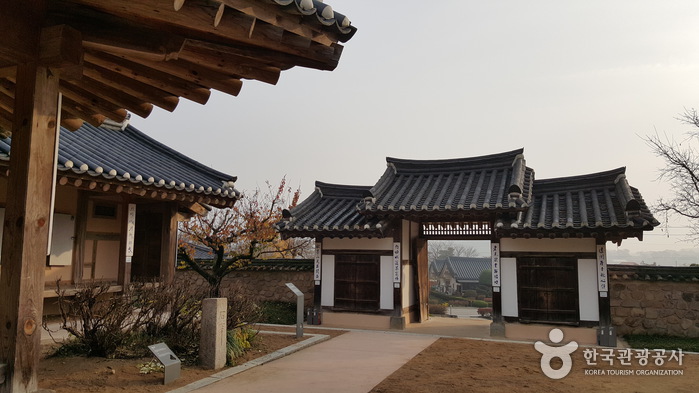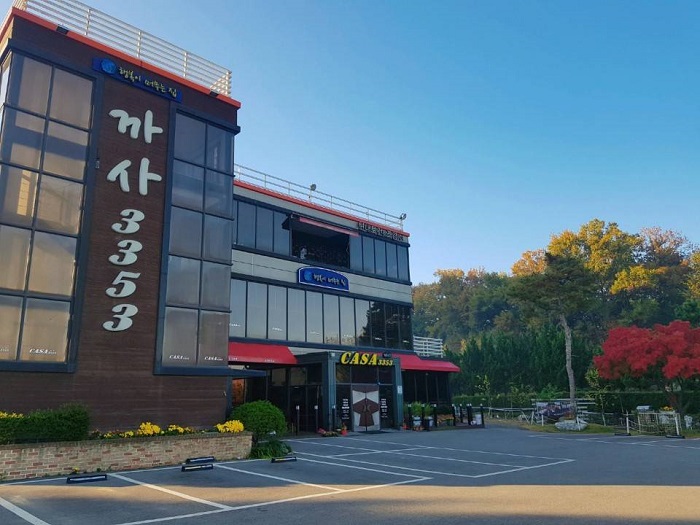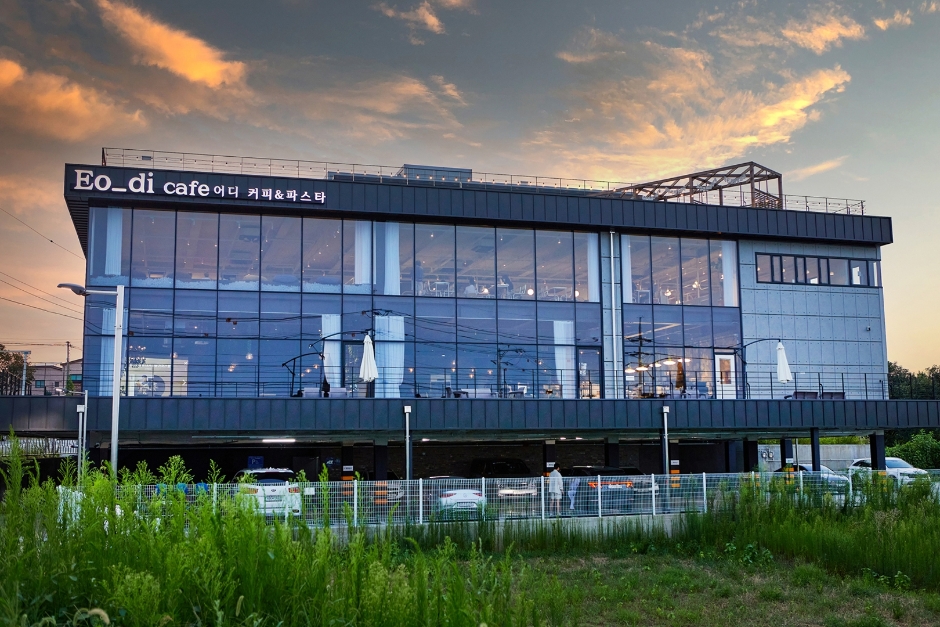House of Chusa (추사고택)
15.9Km 2022-12-28
261, Chusagotaek-ro, Yesan-gun, Chungcheongnam-do
+82-41-339-8248
House of Chusa, Chusa Gotaek in Korean, is the traditional Korean house of the renowned scholar and calligrapher Chusa, also known as Kim Jeong-hui. This old house is known to have been constructed by the great-grandfather of Chusa, Kim Han-Sin.
The Korean-style house compound (266.11 m²) consists of munganchae (a guesthouse), soseuldaemun (a high gate), sarangchae (ㄱ-shaped men's quarters), anchae (ㅁ-shaped women’s quarters) and a shrine where the remains of Chusa are enshrined. Theㄱ-shaped Sarangchae stretches for one kan (traditional measuring unit) to the south and 2 kans to the east and is comprised of two rooms and a daecheongmaru (living area). The Anchae consists of a six-kan daecheongmaru and two one-kan rooms.
Located on the ground is a tomb where Chusa’s great-grandfather (Kim Han-Sin) and his wife (Hwasun Princess) are buried. Nearby, visitors will see a gate that was constructed to commemorate Princess Hwasun’s faithfulness to her husband.
Located approximately 600 meters to the north of the old house is a lacebark pine tree, which was designated as a Natural Monument. The lacebark pine tree, originally from northern China, is among the few of its kind in Korea. It is said that Chusa snuck the pine across the border from China (formerly, the Qing dynasty) into the country when he was 25 years old and planted it at the tomb of his great-grandfather. Originally, the tree had three branches, but two were broken and the third branch was damaged. In 1980, the damaged branch was treated and since then, the tree has been kept under strong protection.
House and Tomb of Kim Jeong-hui (추사김정희선생고택·묘)
15.9Km 2024-02-21
261, Chusagotaek-ro, Sinam-myeon, Yesan-gun, Chungcheongnam-do
This house and tomb are where Kim Jeong-hui (pen name: Chusa, 1786-1856), a Joseon-era scholar and artist, lived and was laid to rest. Chusa Memorial Hall and Chusa Experience Center are found next to the house. After studying in Qing China, Kim Jeong-hui served in multiple government posts. He is best known for his unique calligraphical style, which bears his courtesy name (Chusa), and many works of art that survive to this day. The Experience Center offers traditional art experiences inspired by Kim Jeong-hui’s works.
Lotte Himart - Dangjin Lotte Mart Branch [Tax Refund Shop] (롯데하이마트 당진롯데마트점)
16.0Km 2024-04-16
20, Jeongan-ro, Dangjin-si, Chungcheongnam-do
-
Lotte Mart - Dangjin Branch [Tax Refund Shop] (롯데마트 당진점)
16.0Km 2024-04-16
20, Jeongan-ro, Dangjin-si, Chungcheongnam-do
-
CASA3353 (까사3353)
16.2Km 2021-03-23
21-29, Daeban 1-gil, Pyeongtaek-si, Gyeonggi-do
+82-31-681-0075
It is a place where you can eat oven-baked pizza and pasta. This Western dishes restaurant is located in Pyeongtaek-si, Gyeonggi-do. The representative menu is pane pasta.
Olive Young - Pyeongtaek Cheongbuk Branch [Tax Refund Shop] (올리브영 평택청북점)
16.5Km 2024-06-27
340, Ancheong-ro, Cheongbuk-eup, Pyeongtaek-si, Gyeonggi-do
-
Dogo oncheon Station (도고온천역)
16.5Km 2016-11-30
304, Oncheon-daero, Asan-si, Chungcheongnam-do
Dogo oncheon Station opened in June 15, 1922 as Seonjang Station and was relocated to its current location in 2007.
Eo_di Café (어디카페)
16.8Km 2024-04-03
291 Oseongseo-ro, Oseong-myeon, Pyeongtaek-si, Gyeonggi-do
This is a café about 20 minutes away from Pyeongtaek Station. It is located on the riverside and is ideal for enjoying a cup of coffee while admiring the tranquil natural beauty of Pyeongtaek both during the day and at night. On nice days, visitors can enjoy dessert on the roof while taking in the fresh breeze and the scenic view of Pyeongtaek. Brunch is available from 11:00 to 15:00 during lunch and from 17:00 to 19:30 during dinner, with ample seating. The signature dish is Hangover pasta, a seafood pasta with crab, abalone, shrimp, and other seafood that satisfies one's appetite with a spicy flavor that is good for curing a hangover. Sandwich coffees are also available, providing a satisfying dessert time.
Yesan Hwaamsa Temple (화암사 (예산)
16.8Km 2020-04-04
21-29, Yonggung 1-gil, Yesan-gun, Chungcheongnam-do
+82-41-332-9250
Hwaamsa Temple is located near Joseon dynasty's scholar and writer Kim Jeong-hui's, also referred to his pen name Chusa, house. The temple has ties with the ancient writer, as the temple is known to have been repaired and renovated by Kim Jeong-hui's great grandfather. There are no records that explains the foundation of Hwaamsa Temple, and only a timeline of its reconstruction can be found in "Records of Hwaamsa Temple Restoration" plaque, which is displayed in Sudeoksa Temple Museum. The timeline was recorded by Kim Myeong-hee in 1848, and written by Kim Seong-hee, and carved by Cho Seok-shin. The name "Hwaamsa" was given by King Yeongjo (r. 1724-1776).
Himart - Dangjin Branch [Tax Refund Shop] (하이마트 당진점)
17.1Km 2024-04-18
60, Gyeseong 3-gil, Dangjin-si, Chungcheongnam-do
-


![Lotte Himart - Dangjin Lotte Mart Branch [Tax Refund Shop] (롯데하이마트 당진롯데마트점)](http://tong.visitkorea.or.kr/cms/resource/15/2883315_image2_1.jpg)
![Lotte Mart - Dangjin Branch [Tax Refund Shop] (롯데마트 당진점)](http://tong.visitkorea.or.kr/cms/resource/13/2883313_image2_1.jpg)


![Himart - Dangjin Branch [Tax Refund Shop] (하이마트 당진점)](http://tong.visitkorea.or.kr/cms/resource/21/2883321_image2_1.jpg)
 English
English
 한국어
한국어 日本語
日本語 中文(简体)
中文(简体) Deutsch
Deutsch Français
Français Español
Español Русский
Русский